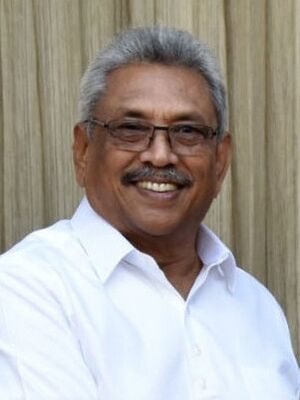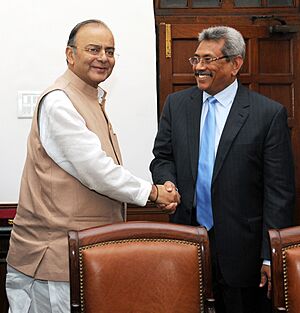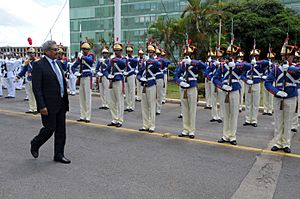Gotabaya Rajapaksa facts for kids
Quick facts for kids
Gotabaya Rajapaksa
RWP RSP
|
|||||||||||||||||||||||||||||||||||||||||
|---|---|---|---|---|---|---|---|---|---|---|---|---|---|---|---|---|---|---|---|---|---|---|---|---|---|---|---|---|---|---|---|---|---|---|---|---|---|---|---|---|---|
| ගෝඨාභය රාජපක්ෂ கோட்டாபய ராஜபக்ஷ |
|||||||||||||||||||||||||||||||||||||||||

Rajapaksa in 2019
|
|||||||||||||||||||||||||||||||||||||||||
| 8th President of Sri Lanka | |||||||||||||||||||||||||||||||||||||||||
| In office 18 November 2019 – 14 July 2022 |
|||||||||||||||||||||||||||||||||||||||||
| Prime Minister | Ranil Wickremesinghe Mahinda Rajapaksa |
||||||||||||||||||||||||||||||||||||||||
| Preceded by | Maithripala Sirisena | ||||||||||||||||||||||||||||||||||||||||
| Succeeded by | Ranil Wickremesinghe | ||||||||||||||||||||||||||||||||||||||||
|
|||||||||||||||||||||||||||||||||||||||||
| Personal details | |||||||||||||||||||||||||||||||||||||||||
| Born |
Nandasena Gotabaya Rajapaksa
20 June 1949 Palatuwa, Dominion of Ceylon |
||||||||||||||||||||||||||||||||||||||||
| Citizenship | Sri Lanka (1949–2003, 2005–present) United States (2003–2019) |
||||||||||||||||||||||||||||||||||||||||
| Political party | Sri Lanka Podujana Peramuna | ||||||||||||||||||||||||||||||||||||||||
| Spouse |
Ayoma Rajapaksa
(m. 1980) |
||||||||||||||||||||||||||||||||||||||||
| Children | 1 | ||||||||||||||||||||||||||||||||||||||||
| Parents | Don Alwin Rajapaksa (father) Dandina Samarasinghe née Dissanayake (mother) |
||||||||||||||||||||||||||||||||||||||||
| Relatives | Chamal (brother) Mahinda (brother) Basil (brother) |
||||||||||||||||||||||||||||||||||||||||
| Education | Sri Lanka Military Academy University of Colombo |
||||||||||||||||||||||||||||||||||||||||
| Military service | |||||||||||||||||||||||||||||||||||||||||
| Allegiance | |||||||||||||||||||||||||||||||||||||||||
| Branch/service | |||||||||||||||||||||||||||||||||||||||||
| Years of service | 1971–1991 | ||||||||||||||||||||||||||||||||||||||||
| Rank | |||||||||||||||||||||||||||||||||||||||||
| Unit | Gajaba Regiment | ||||||||||||||||||||||||||||||||||||||||
| Commands | 1st Gajaba Regiment General Sir John Kotelawala Defence Academy |
||||||||||||||||||||||||||||||||||||||||
| Battles/wars | Sri Lankan Civil War 1987–1989 JVP insurrection |
||||||||||||||||||||||||||||||||||||||||
| Awards | |||||||||||||||||||||||||||||||||||||||||
Nandasena Gotabaya Rajapaksa (born 20 June 1949) is a Sri Lankan politician and former military officer. He was the eighth President of Sri Lanka from 2019 to 2022. He is the first person with a military background to become Sri Lanka's president.
Before becoming president, he was the Secretary to the Ministry of Defence. This was during the time his brother, Mahinda Rajapaksa, was president. In this role, he was a key figure in ending the Sri Lankan Civil War.
His time as president was marked by serious challenges. His government struggled to manage the COVID-19 pandemic. The country also faced a major economic crisis, which led to shortages of food, fuel, and medicine. These problems caused large protests across the country.
The protests grew so large that Rajapaksa had to leave the country. He resigned on July 14, 2022, becoming the first Sri Lankan president to leave office in the middle of his term.
Contents
Early Life and Family
Gotabaya Rajapaksa was born in Palatuwa, in the Matara District of Sri Lanka. He grew up in a family that was very involved in politics. His father, D. A. Rajapaksa, was a Member of Parliament and a government minister.
His older brother, Mahinda Rajapaksa, also became a powerful politician, serving as Prime Minister and later as President. Two of his other brothers, Chamal Rajapaksa and Basil Rajapaksa, have also been Members of Parliament. Gotabaya attended Ananda College, Colombo for his schooling.
Military Career
In 1971, at the age of 21, Rajapaksa joined the Sri Lankan Army. After training, he became an officer. He served in the army for 20 years and became a Lieutenant Colonel.
He was part of several major military operations during the Sri Lankan Civil War. This was a long and difficult conflict in Sri Lanka. He also served during a time of unrest known as the 1987–1989 JVP insurrection. He retired from the army in 1991.
After leaving the army, he studied information technology at the University of Colombo. In 1998, he moved to the United States and worked for Loyola Law School in Los Angeles.
Secretary of Defence
In 2005, his brother Mahinda was elected president, and Gotabaya returned to Sri Lanka to help him. He was appointed as the Secretary to the Ministry of Defence. In this powerful job, he was in charge of the military. He played a central role in the government's plan to end the civil war, which it did in 2009.
As Defence Secretary, he was also involved in city development projects. He helped beautify the city of Colombo by improving parks and public spaces.
In December 2006, there was an attempt to assassinate him in Colombo. A vehicle with explosives tried to ram into his motorcade, but his guards stopped it. Rajapaksa was not harmed.
Becoming President

In 2019, Rajapaksa decided to run for president. He promised to focus on national security and a strong economy. Many people supported him because of his military background and his role in ending the civil war.
He won the election in November 2019 with over 52% of the vote. He became the first former military officer to be elected president of Sri Lanka. After he won, his brother Mahinda became the Prime Minister. This was a rare situation where two brothers held the top two leadership positions in a country.
Presidency (2019–2022)

Rajapaksa's presidency faced major difficulties almost from the start.
COVID-19 Pandemic
Soon after he took office, the COVID-19 pandemic spread across the world. His government put curfews in place to stop the virus from spreading. The pandemic badly hurt Sri Lanka's economy, especially the tourism industry, which is very important for the country.
Economic Crisis
Under Rajapaksa's government, Sri Lanka faced its worst economic crisis since independence. The government made large tax cuts, which meant it collected less money. The country's supply of foreign money ran very low.
This led to huge shortages of essential items like fuel, cooking gas, food, and medicine. People had to wait in long lines for basic goods, and there were power cuts that lasted for many hours.
Nationwide Protests
The economic crisis made people very angry. In early 2022, large protests began all over Sri Lanka. People blamed President Rajapaksa and his government for the problems and demanded that he resign. The protests, known as the "Aragalaya" (Struggle), went on for months.
The government tried to stop the protests by using emergency laws and curfews, but the people did not give up.
Resignation and Exile
On July 9, 2022, the protests reached a boiling point. Thousands of protesters broke past police barriers and entered the President's official house in Colombo. Rajapaksa had already left the residence for his safety.
Realizing he had lost the support of the people, Rajapaksa agreed to step down. On July 13, he left Sri Lanka on a military plane to the Maldives. From there, he flew to Singapore. On July 14, 2022, he sent his official resignation by email. He was the first president in Sri Lanka's history to resign before his term was over.
After spending 52 days outside the country, he returned to Sri Lanka on September 2, 2022. As a former president, he was given a house and security.
See also
 In Spanish: Gotabaya Rajapaksa para niños
In Spanish: Gotabaya Rajapaksa para niños
- Eelam War IV
- List of political families in Sri Lanka


